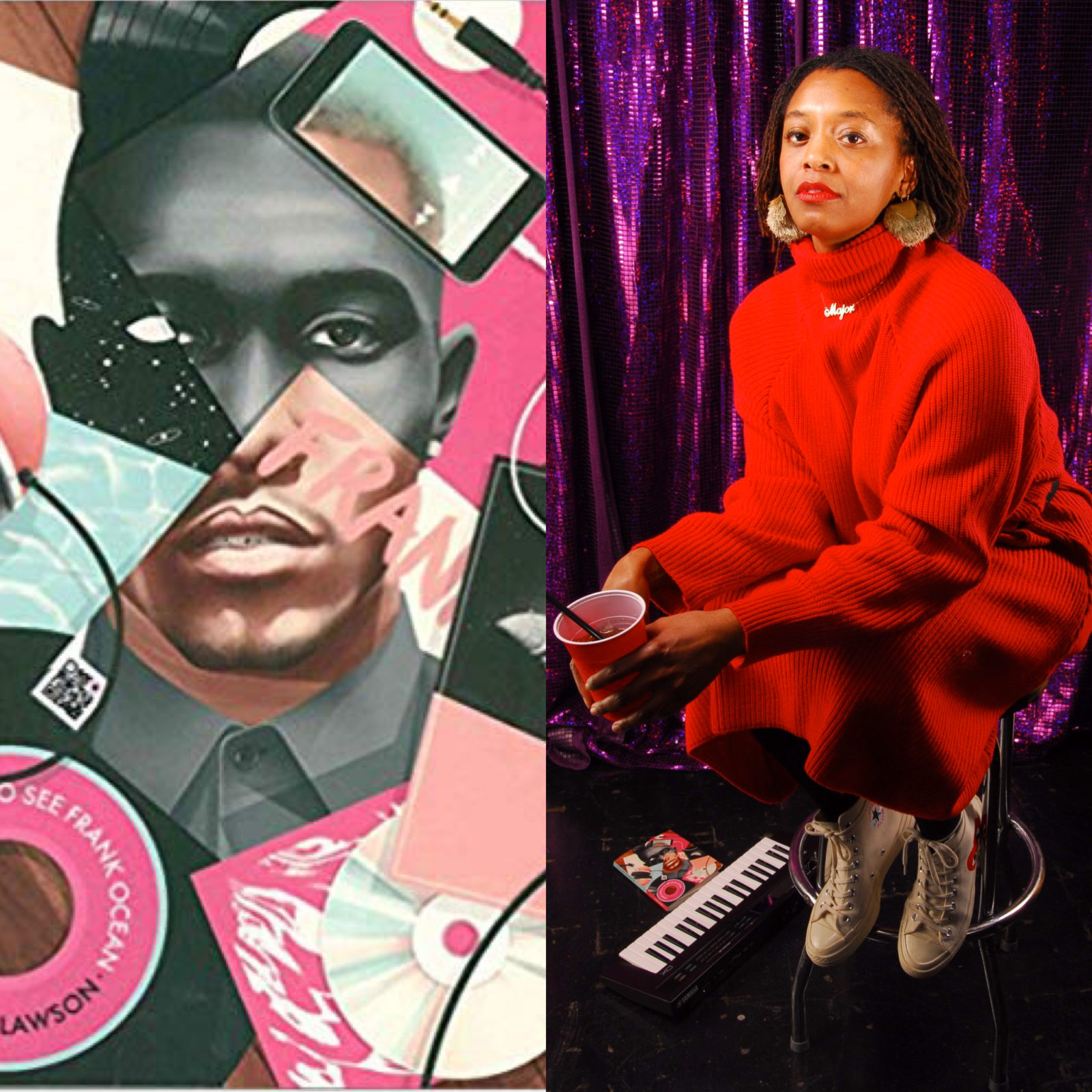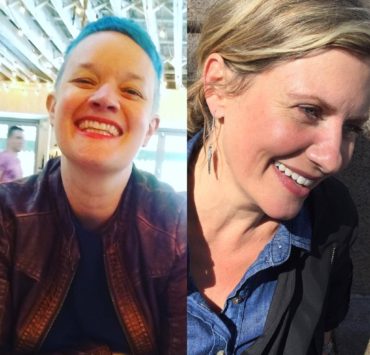
“Of course, when I say, ‘Ocean’
I am thinking of myself —how every time
I approach she is never the same
—Shayla Lawson, “Seigfried”
After first hearing “Forrest Gump” by Frank Ocean, I put the track on repeat and reimagined my days in high school. In this version, I was happy and love-struck, watching a sweetheart run a touchdown across the football field. I envisioned an environment that allowed for such a dream: my chilly body in the cusp of fall and winter, layered in clothing, and locking-arms with another boy in the squeaky bleachers after his game. When you listen to a song you like, what significance do you impose onto the narrative? Do you imagine yourself in the story of its lyrics? Plant your own histories or moods within it? Shayla Lawson enacts these questions and more in her book, I Think I’m Ready to See Frank Ocean, a project that embodies what it means to listen to an album, to experience it, to tread in it, and to be—even if only temporarily—transformed.
The book begins, in the same way that Frank Ocean’s debut album does, with a track—and we might think of each poem as a track in Lawson’s book—called “Start.” Shayla begins:
The name of how music plays / often means what it is: A record—a witness; a cassette—a small blank conch
In the poem, Lawson implies how a listener, or a reader, relates to a track: as a witness. But a witness, here, is something more than passive—someone who not only observes but is now part of what’s transpired, swimming in the thick of it all. Too, her word choice, by what form of technology is not stated outright, conjures the idea of an album: a blank vessel to fill with one’s own stories. An archive of moments that bring us love or joy. Here the nouns and verbiage of music become one with memory, just as time collapses when we listen to words that make us feel something.
Throughout I Think I’m Ready to See Frank Ocean, Lawson incorporates directly quoted lyrics (appearing in italics in the book) in new ways. One might think of this not quite as erasure, but as reapplication. For example, in the poem “Thinking Bout You” Lawson begins,
“Never let an ocean love you. He’ll take
an eternity to do so.”
What was originally, in Frank Ocean’s track, “’cause I’ve been thinkin bout forever,” in Lawson’s work, becomes:
“let an ocean love you. He will only take forever”.
Whereas Frank Ocean’s song details his imagining the “forever” of a potential love, Lawson’s poem is about absence, of being left behind. Is the poem a love story? Commentary on Ocean himself? Commentary on a God that often leaves us waiting? Could it be all of these at once?
The focus is of Lawson’s text is not just music. I Think I’m Ready to See Frank Ocean is a book that interpolates Frank Ocean—his image, his lyrics, his enigma—into poetry and lyric. The meanings and remixes present are heavily informed by the mythos of the titular artist, and his history (and mystery), are integral to Lawson’s engagement with his figure.
Frank Ocean’s debut mixtape Nostalgia, Ultra was released in 2011, and later secured him a record contract with Def Jam. His debut album, Channel Orange, solidified his existence in a new contemporary R&B canon. The deployment of pronouns in “Thinking Bout You,” (“My eyes don’t shed tears, but boy they bawl when I’m thinking ‘bout you”) sparked discussions of Ocean’s sexual orientation prior to the album’s release. On July 4th 2012 Ocean “came out” in a Tumblr post, preceding the album’s drop. He went on to win the Grammy for Best Urban Contemporary Album.
Frank Ocean became an icon of a millennial, queer Blackness. Fans patiently awaited his next move. What would he produce next? Could he live up to his own hype? Would he fizzle out and fade into oblivion? The delays in new music only added to an enigmatic quality, and an ethereal, divine distance began to surround his name. It took four years until his next solo release—an eternity in industry-time.
Structurally, I Think I’m Ready to See Frank Ocean makes its way through the titular musician’s body of work: split into five sections—four devoted to each of his four official full-length releases, and one section devoted to an imagined Ocean persona, sandwiched in the middle. The book, too, functions as an album. Full of switches in mood, turns, interludes, and even ending in liner notes.
Content-wise, the book covers all identities associated with Ocean’s persona—both his queerness and his, distinctly American, Blackness. Across its sections, Lawson ruminates on race, on love, and on sex, sometimes all at once.. The poems that Lawson has crafted use his name as symbol too. Across the book the noun “ocean” functions as a symbol for many things: Frank himself, Hurricane Katrina, Black ancestry, and time. “Ocean” attends to folks whose trajectories were stolen across the Atlantic.
The dynamic nature of language is thrilling here. Shayla Lawson takes Frank Ocean’s track from Blond about love that has been lost, and turns it into something different in the poem “White Ferrari.” What begins as a description of a couple in the air, on a ride at the State Fair swiftly shifts:
…I look at pictures of white
people & wonder what it feels like to
land. Have you ever felt like that?
Where
the ocean is simply a place
you’ve been? Like being vapor
is a thing you can vacat
-ion from?
The legacy of enslavement is palpable here. What does it feel like to land? To have land? Where the ocean is somewhere you’ve been, not somewhere your being still occupies? What does it mean when we question these things next to a person whom we love? Additionally, Lawson, approaches, like Ocean, queer identity in this interrogative context. In a section “the Ocean is ENDLESS”, Lawson asks heady, reflexive questions about a relationship:
“Was our love queer? Was it unusual? Do I have the right to attribute strangeness to my body?”
And the implications are that it is Frank Ocean’s work—the rumination and reflection on his music—that brought about these questions of queerness, of land.
Lawson is showing us, this is where music can take us. Music conjures all of these things washed up in waves. The poetry between the two writers crashes into each other. Later, she continues:
“I liked having you round.
I liked having you in circles.”
Integral to the mechanics of I Think I’m Ready to See Frank Ocean is the reality that Frank Ocean is himself a creation. When beginning his music career, Ocean changed his name from Christopher “Lonny” Breaux to Frank Ocean. Some say, the stage name is inspired by the identity-shifting con artists of the Ocean’s 11 franchise, while others can’t help but posit that the name implies a more symbolic impact by the waves (in “Nights” the singer speaks of being displaced after Katrina). Regardless, “Frank Ocean” is a stage name-cum-legal name, a marker of his tendency toward recreation—whether that be through crafting his own identity or through the imagined stories that he tells in his songs.
“Sierra Leone” was a standout track on Channel Orange—a short R&B tune that crescendos from a story about an unexpected pregnancy, to Frank Ocean imagining himself as a father, watching his lover breastfeed their daughter before bedtime. Through storytelling, he spins the narrative into a quite beautiful act, and it seems that Lawson is in on this too.
In her poem, “Sierra Leone” she too, creates beauty, writing:
“The infant
gums my
covered nipple.
I hug
& I pray
this is
the only
way she
will ever
be touched.”
In an interview with Indiana Review, Lawson speaks about I Think I’m Ready to See Frank Ocean saying, “In it, I take the work of the titular singer as a way to archive acts of love.” This feels accurate—the book as an album filled with snapshots of intimacy with characters and emotions that don’t often get cataloged. Lawson seems invested in care here (“He don’t care for me, but he cares for me”), in the care people perform for one another. This is what Ocean is invested in doing, too. He is creating narratives, some true, some half-truths, all circulating around love. I hadn’t quite put this together until reading Lawson’s work. She exalts Frank here. Through form, Lawson is honoring remixing and recreation, just as Ocean does.
Finally, the question for me as a reader becomes, if this is a recording of acts of love, then what do we do with the more torrential waters, the moments that seem less focused on joy? The answer may be located in the album’s final (unhidden) track. In “Futura Free” Lawson writes:
“in ocean
-ography, a corpse
takes two-hundred fifty million
years to return to the deep
sea completely. Submerged
to our chests, our cheeks, we still
spit & swallow the dead
matter—us enslaved
people. What does it mean to say we
encounter bodies
of water?”
Perhaps we too often conflate love and joy in the contemporary moment. Love and joy can go hand and hand, but can’t love look like acknowledgement, or sacrifice? Can’t love look like a reckoning with the submerged? Lawson is interrogating and complicating how we think of love in this book. She’s using Frank Ocean as a guide while creating something wholly innovative and distinct.
We place ourselves in the music we love. We sing in the shower. We hum in the company of loved ones. We listen to sad songs in bed, under the covers. This is what I Think I’m Ready to See Frank Ocean embodies, an extension of what having an album on repeat does to ourselves, to others, when we listen. I Think I’m Ready to See Frank Ocean is a beautiful piece of art. Surround yourself with it. Surround yourself with love.
Shayla Lawson is the author of three books of poetry—A Speed Education in Human Being, the chapbook PANTONE and I Think I’m Ready to see Frank Ocean—and the forthcoming essay collection THIS IS MAJOR (Harper Perennial, 2020). Her work has appeared in print & online at Tin House, PAPER, ESPN, Salon, Guernica, & others. She curates The Tenderness Project with Ross Gay and writes poems with Chet’la Sebree (pronounced Shayla, no relation). A MacDowell and Yaddo Artist Colony Fellow, Shayla Lawson is a member of The Affrilachian Poets & currently serves as Writer-in-Residence and Director of Creative Writing at Amherst College.
I Think I’m Ready To See Frank Ocean is available for purchase here.
Image credit: Brick Kyle

Steffan Triplett is a Black, queer writer and educator from Joplin, Missouri. He received his MFA from the University of Pittsburgh and is a graduate of Washington University in St. Louis where he was a John B. Ervin Scholar. Some of Steffan's work can be found in Longreads, Electric Literature, DIAGRAM, Fence, Nepantla: An Anthology Dedicated to Queer Poets of Color (Nightboat Books 2018), and the forthcoming Revisiting the Elegy in the Black Lives Matter Era (Routledge 2020). Steffan has been a fellow for Callaloo and Lambda Literary and his work has been nominated for Best of the Net, the Pushcart Prize, and was the winner of the Brutal Nation Prize in Prose. His manuscript-in-progress was Shortlisted for the 2019 Tarpaulin Sky Book Awards.







